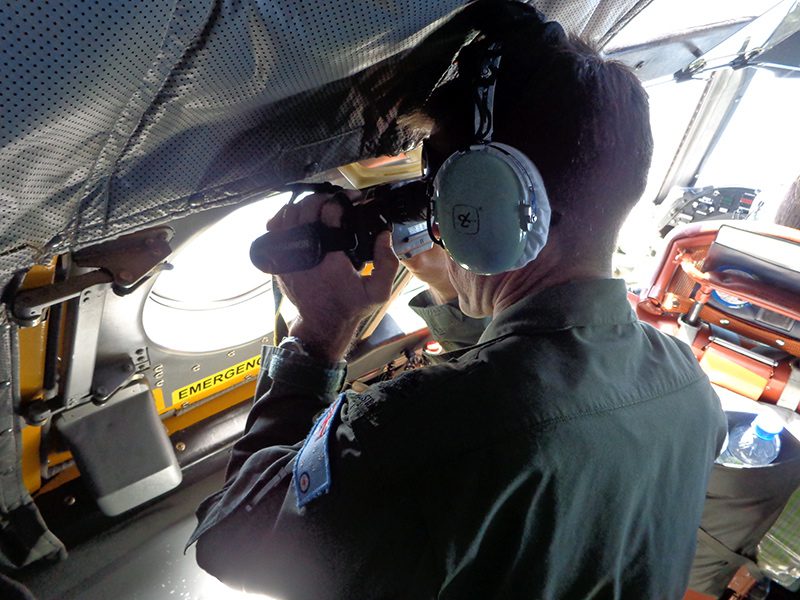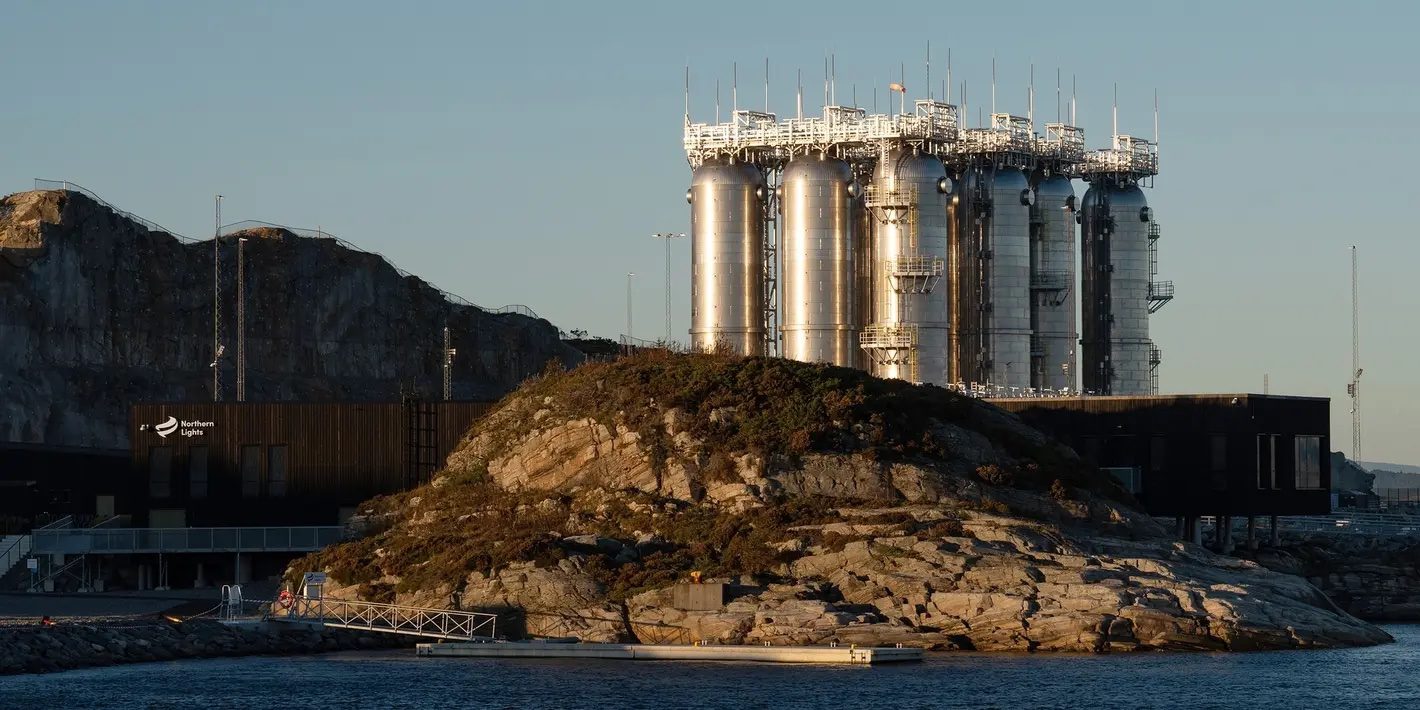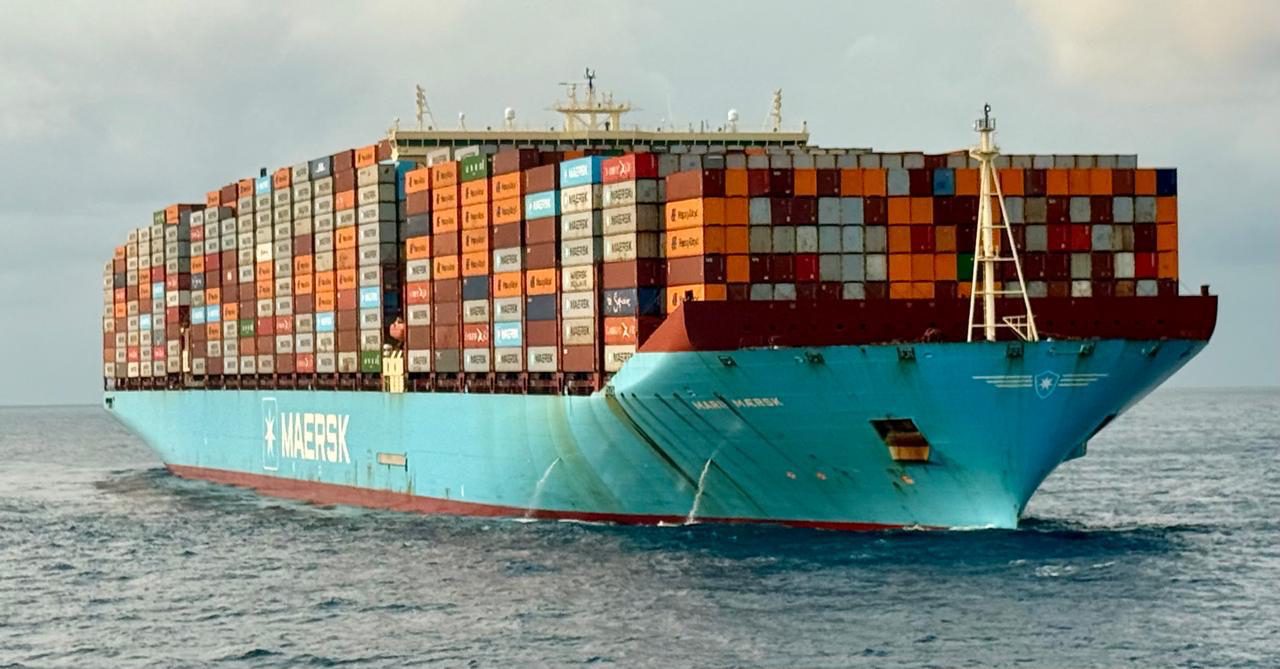A Royal Australian Air Force crew member of an AP-3C Orion maritime patrol aircraft scans the surface of the sea during a search sortie to the west of Peninsula Malaysia. Royal Australian Air Force Photo
By Gopal Ratnam and David Lerman
March 19 (Bloomberg) — Even in this high-tech age, the search for missing Malaysian Air Flight 370 may rely on good luck and the oldest of sensors: the human eye.
After a futile search in the Andaman Sea that produced 400 radar contacts and no sign of aircraft debris or other clues, the U.S. Navy has sent its most advanced surveillance plane, a P8-A Poseidon, to join planes from Australia and New Zealand in scanning an area of the southern Indian Ocean that’s now been whittled in half to about the size of Italy.
While Navy surveillance planes are equipped with radar, cameras and electro-optical sensors, searching for objects on open water is an arduous task, with sailors at every window looking with binoculars and the plane diving to identify targets visually, said Michael Boston, a retired U.S. Navychief petty officer who’s served as an electronic warfare specialist on P3-C Orion surveillance plane.
With few clues to the location of the jetliner missing since March 8, the vastness of the Indian Ocean and the limitations of the P-8 and the older P-3 in finding anything beneath the water’s surface, “it’s a daunting challenge,” said Richard Burgess, a retired P3-C mission commander.
No Signs
A Royal Australian Air Force AP-3C, which made the first sortie to the search area yesterday, covered about 25,000 square miles (65,000 square kilometers) under good search conditions without seeing any signs of debris, said John Young, general manager of emergency response for the Australian Maritime Safety Authority.
A successful search would require finding objects such as life rafts, seat cushions, evacuation chutes, luggage and possibly bodies floating in the water, said Burgess, managing editor of Seapower Magazine, a publication of the Navy League, based in Arlington, Virginia.
The P8’s crew will fly at an altitude of about 5,000 feet (1.52 kilometers), dropping at times to 1,000 feet to eyeball objects picked out by radar.
The plane will fly one flight each day for three days followed by a day off for maintenance, according to the Navy. A U.S. P3-C Orion that had completed a search mission in the Bay of Bengal is on standby for the next 48 hours in case it’s required to search in the area of Cocos (Keeling) Islands, north-west of Perth, Australia, the Navy said.
‘Roaring Forties’
Much of the area is within the Roaring Forties, a region between the 40th and 50th degrees of latitude south known for strong winds and wave conditions, according to charts provided by the Australian Maritime Safety Authority.
Investigators have determined the Beijing-bound flight from Kuala Lumpur was deliberately steered off course to the west. Whoever was piloting the jetliner turned off the plane’s transponder, which helps radar pinpoint location, and a text-to- ground messaging system.
The search area for Flight 370 is based on what was described by U.S. authorities as its most likely last-known position based on satellite transmissions, adjusted to reflect water movement and weather since March 8 and assumptions about aircraft speed, John Young, the Australian authority’s general manager for emergency response, said at a briefing yesterday.
“While the process may seem simple, factors such as the number of ships or objects in the area, sea state, drift rate, and visibility can affect how much area we’re able to cover,” Lieutenant Joshua Mize, a tactical coordinator aboard the U.S. P8-A search plane, said in a statement distributed by theNavy.
Earlier Search
An earlier search by the P8-A in the seas north of the Strait of Malacca yielded 400 radar contacts, the Navy’s 7th Fleet said in a statement. “Unfortunately, none were associated with aircraft debris or wreckage,” the Navy said.
Now the P8-A, a heavily modified version of Chicago-based Boeing Co.’s 737 commercial airliner, is joining two Royal Australian Air Force AP-3C Orion surveillance aircraft to hunt for Flight 370 in an area of the open ocean where the crew will confront sea currents and high winds.
The P8-A is the Navy’s newest surveillance plane. The P-3C Orion is a four-engine turboprop built by Lockheed Martin Corp., based in Bethesda, Maryland, and has been in service in the Navy since the 1960s.
Flying at 288 to 311 miles per hour (250 to 270 knots), the Poseidon can search for as long as nine hours, “depending on the transit distance some flights may only have two-three hours of search time” Mize said.
Search Patterns
Surveillance planes use different search patterns depending on the object being tracked and other details about the target, said Boston, now based in Troy, Virginia.
“If the exact last position is known, the Navy will typically assign an expanding circle” from that starting point, known as the datum, which expands at the rate a submarine or target is known to be moving, he said.
In the search for the missing airliner, the Navy is more likely to use a ladder pattern, starting from a map coordinate with a series of parallel flight legs connected by turns in an expanding search square, said Lieutenant Commander Katie Cerezo, a Navy spokeswoman.
Depending on the mission, commanders have to make a series of calculations on how high to fly, the length of a single track and the spacing between tracks to mount an effective search, Boston said.
To make visual contact with objects detected by radar while flying at a higher altitude, the plane has to descend, and that could add time, he said. “At 24,000 feet if you detect with radar, you can’t see it visually. It takes as much as 15 minutes to descend, and by that time the object could submerge and resurface 20 minutes later.”
Oil Drum
Once while flying on a surveillance mission in the north Arabian Sea in the early 1990s, Boston said, his P3-C Orion’s radar spotted an object about 3 feet tall and 2 feet wide on the water that looked like a submarine’s periscope. “So we descended right on top of it, to about 200 feet,” only to discover it was a discarded oil drum.
If the crew detects anything or is given more precise search locations, they could drop sonobuoys — launched from the plane’s belly — that act like underwater microphones to listen for any “pings” from the missing plane’s black boxes, Burgess said. The pingers are supposed to emit signals for 30 days after becoming immersed in water.
Yet those buoys may be of little use without a clue to the missing plane’s location. “It would be a big waste of money to drop them randomly,” he said.
Black Box
While the black boxes are designed to withstand depths of 20,000 feet (3.8 miles) and may work in even deeper water, the range of the pings is a mile, according to manuals from Honeywell International Inc., the maker of the equipment. That may make the signals difficult to pick up even if an underwater microphone is over the correct location.
It can be difficult to hear the pingers if they are blocked by undersea mountains, said Dave Gallo, director of special projects at the Woods Hole Oceanographic Institution in Massachusetts, in an interview. Layers of water with different temperatures can also block sounds, he said.
The emergency locator transmitters on a 777 are designed for land and don’t work underwater, nor do the satellite transmissions that investigators have used to triangulate the likely last-known location.
“I just don’t have a lot of hope for success in this effort because of the distance the plane could have gone,” Burgess said.
“At some point, you have to decide whether it’s worth it or not anymore,” he said. “Your hope of finding something goes down as time goes on. I would call it off in three or four days” if nothing is found.
–With assistance from Thomas Black in Dallas, David Fickling in Sydney and Alan Levin in Washington.
Copyright 2014 Bloomberg.

 Join The Club
Join The Club











